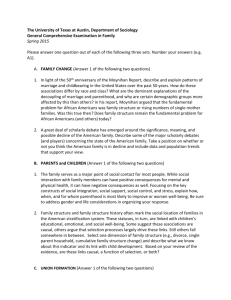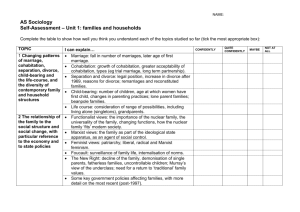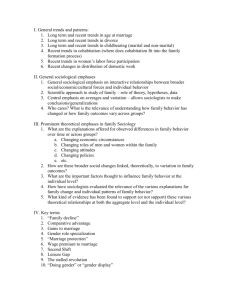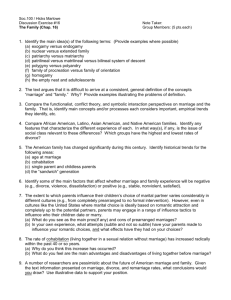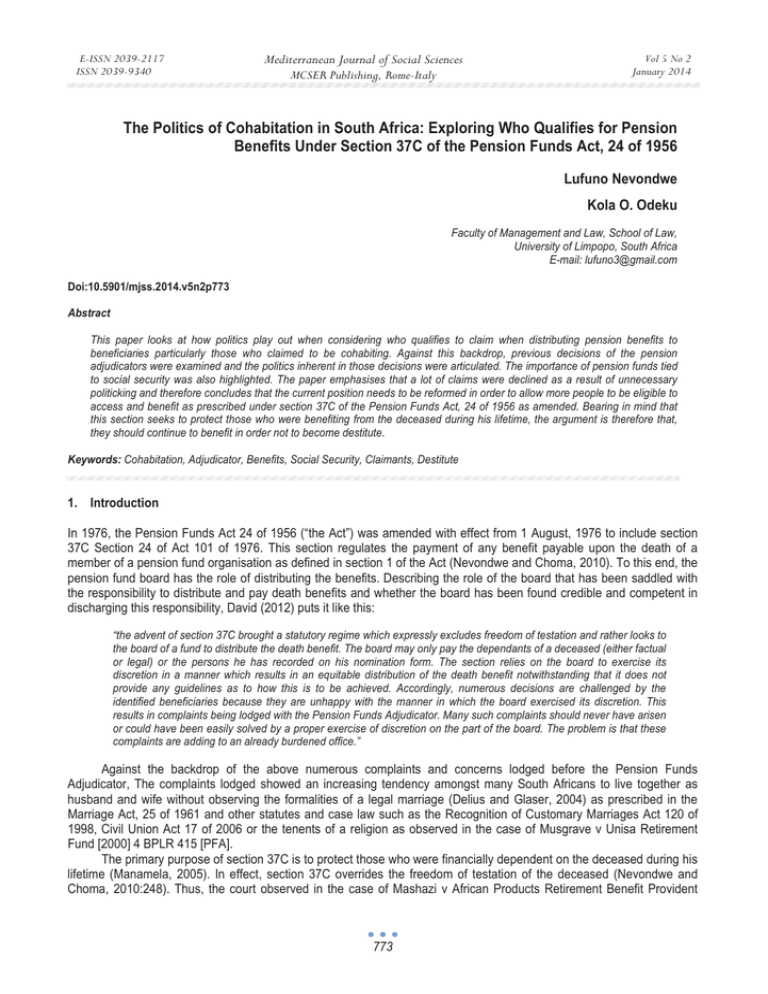
E-ISSN 2039-2117
ISSN 2039-9340
Mediterranean Journal of Social Sciences
MCSER Publishing, Rome-Italy
Vol 5 No 2
January 2014
The Politics of Cohabitation in South Africa: Exploring Who Qualifies for Pension
Benefits Under Section 37C of the Pension Funds Act, 24 of 1956
Lufuno Nevondwe
Kola O. Odeku
Faculty of Management and Law, School of Law,
University of Limpopo, South Africa
E-mail: lufuno3@gmail.com
Doi:10.5901/mjss.2014.v5n2p773
Abstract
This paper looks at how politics play out when considering who qualifies to claim when distributing pension benefits to
beneficiaries particularly those who claimed to be cohabiting. Against this backdrop, previous decisions of the pension
adjudicators were examined and the politics inherent in those decisions were articulated. The importance of pension funds tied
to social security was also highlighted. The paper emphasises that a lot of claims were declined as a result of unnecessary
politicking and therefore concludes that the current position needs to be reformed in order to allow more people to be eligible to
access and benefit as prescribed under section 37C of the Pension Funds Act, 24 of 1956 as amended. Bearing in mind that
this section seeks to protect those who were benefiting from the deceased during his lifetime, the argument is therefore that,
they should continue to benefit in order not to become destitute.
Keywords: Cohabitation, Adjudicator, Benefits, Social Security, Claimants, Destitute
1. Introduction
In 1976, the Pension Funds Act 24 of 1956 (“the Act”) was amended with effect from 1 August, 1976 to include section
37C Section 24 of Act 101 of 1976. This section regulates the payment of any benefit payable upon the death of a
member of a pension fund organisation as defined in section 1 of the Act (Nevondwe and Choma, 2010). To this end, the
pension fund board has the role of distributing the benefits. Describing the role of the board that has been saddled with
the responsibility to distribute and pay death benefits and whether the board has been found credible and competent in
discharging this responsibility, David (2012) puts it like this:
“the advent of section 37C brought a statutory regime which expressly excludes freedom of testation and rather looks to
the board of a fund to distribute the death benefit. The board may only pay the dependants of a deceased (either factual
or legal) or the persons he has recorded on his nomination form. The section relies on the board to exercise its
discretion in a manner which results in an equitable distribution of the death benefit notwithstanding that it does not
provide any guidelines as to how this is to be achieved. Accordingly, numerous decisions are challenged by the
identified beneficiaries because they are unhappy with the manner in which the board exercised its discretion. This
results in complaints being lodged with the Pension Funds Adjudicator. Many such complaints should never have arisen
or could have been easily solved by a proper exercise of discretion on the part of the board. The problem is that these
complaints are adding to an already burdened office.”
Against the backdrop of the above numerous complaints and concerns lodged before the Pension Funds
Adjudicator, The complaints lodged showed an increasing tendency amongst many South Africans to live together as
husband and wife without observing the formalities of a legal marriage (Delius and Glaser, 2004) as prescribed in the
Marriage Act, 25 of 1961 and other statutes and case law such as the Recognition of Customary Marriages Act 120 of
1998, Civil Union Act 17 of 2006 or the tenents of a religion as observed in the case of Musgrave v Unisa Retirement
Fund [2000] 4 BPLR 415 [PFA].
The primary purpose of section 37C is to protect those who were financially dependent on the deceased during his
lifetime (Manamela, 2005). In effect, section 37C overrides the freedom of testation of the deceased (Nevondwe and
Choma, 2010:248). Thus, the court observed in the case of Mashazi v African Products Retirement Benefit Provident
773
E-ISSN 2039-2117
ISSN 2039-9340
Mediterranean Journal of Social Sciences
MCSER Publishing, Rome-Italy
Vol 5 No 2
January 2014
Fund [2002] 8 BPLR 3703 (W) at 3705J-3706C) that, although the deceased may have expressed an intention to benefit
a certain nominated beneficiary in his nomination form, it does not necessarily imply that the whole amount of the benefit
will in fact be awarded to the person because the deceased’s intention as contained in his nomination form is only one of
the factors taken into consideration when allocating a death benefit. Against the backdrop of this, Marx and Hanekom
(2007), are of the view that it is the board’s responsibility when dealing with the payment of death benefits to conduct a
thorough investigation to determine the beneficiaries, to thereafter decide on an equitable distribution and finally to
decide on the most appropriate mode of payment of the benefits payable. Mango (2008) also supported this position and
averred that the board is under an obligation to discharge the responsibility of carrying out investigation in order to
establish the veracity of the claims before payment or distribution of benefits.
Hayton (2004), relying on the Pension Funds Act articulates the basic duties of the trustees thus “the basic duties
of "pension trustees" (as board members of a pension fund shall hereafter be called) are to ensure proper records are
kept, proper control systems are in place, and adequate and appropriate information is communicated to members; to
take all reasonable steps to ensure contributions are paid promptly to the fund; to obtain expert advice where sufficient
expertise is lacking; and to ensure that the rules and the operation and administration of the fund comply with the
Pensions Fund Act 1956 (as amended), the Financial Institutions (Investment of Funds) Act 2001 and all other applicable
laws... It is noteworthy that, to safeguard its assets, no fund may carry on any business other than the business of a
pension fund…Not only must the fund or a trustee not act in excess of its, his or her powers, but each must not exercise
the fund’s powers improperly nor cause a fund member to sustain actual or possible prejudice in consequence of the
maladministration of the fund…In directing, controlling and overseeing the operations of the fund the trustees must (a)
take all reasonable steps to ensure that the interests of the members in terms of the rules of the fund and the provisions
of the 1956 Act (as amended) are protected at all times; (b) act with due care, diligence and good faith; (c) avoid conflicts
of interest; and (d) act impartially in respect of all members and beneficiaries.”
In exercising their discretion, trustees are required to consider relevant factors and ignore irrelevant facts. Towards
this end, the court said in the case of Sithole v ICS Provident Fund and Another [2004] 4 BPLR 430 (PFA) that the
trustees are required to exercise that discretionary power properly and not fetter their discretion. What the Act does not
prescribe however, are the factors to be taken into account in exercising that discretion. The import of this is that the
trustees are given an unfettered discretion to determine which dependant will share in the benefit, to the point of granting
a nil benefit to other dependents (Nevondwe and Rapatsa, 2012). The rider is, of course, always that the board must
exercise its discretion properly by considering relevant factors and ignoring irrelevant ones. In TWC and Others v
Rentokil Pension Fund and another [2000] 2 BPLR 216 (PFA) at 224 H-225C and Sithole v ICS Provident Fund and
Another [2000] 4 BPLR 430 (PFA), at paragraphs 24 and 25 the following guidelines were set out:
“the fund should have regards to a basket of factors including (but not limited to):
x
x
x
x
x
x
the age of the parties;
the relationship with the deceased;
the extent of the dependency;
the wishes of the deceased
the financial affairs of the dependants; and
the future earning potential and prospects of the dependants.”
2. The Meaning of Cohabitation
Cohabitation can be defined as a stable monogamous relationship where couples who do not wish to, or are not allowed
to, get married, live together as spouses ( Blossfeld et al. 1999). This definition includes people of the same sex living
together in a stable, exclusive relationship (Hutchings and Delport, 1992). Some authors still use the more traditional
definition that limits the term cohabitation to two people of the opposite sex living together (Bumpass et al. 1991.
Towards this end, they understand cohabitation to mean the dwelling or living together of a man and wife (Manning and
Smock, 2005). According to Cronjie and Heaton (2004:227), “cohabitation refers to the two partners who are living
together outside marriage in a relationship which is analogous to or has most of the characteristics of a marriage.”
Explaining the changing meaning of cohabitation in the Netherlands, Manting (1996) indicated that “the social
meaning of both marriage and cohabitation has changed. Cohabitation started as an alternative way of living, developed
into a temporary phase before marriage, and finally became a strategy for moving into a union gradually... The
774
E-ISSN 2039-2117
ISSN 2039-9340
Mediterranean Journal of Social Sciences
MCSER Publishing, Rome-Italy
Vol 5 No 2
January 2014
conclusion that both cohabitation and marriage have changed in nature over historical time raises the question whether
or not historical fluctuations are present in the influence of forces underlying patterns of cohabitation and marriage.”
Cronjie and Heaton (1999) has observed that ssince the coming into operation of the Civil Union Act, marriage is
no longer a relationship between a man and women only to the exclusion of all other persons. Accordingly, in terms of
section 1, Civil Union Act defines civil union or marriage as the voluntary union of two persons who are both 18 years of
age or older which is solemnized and registered by way of either a marriage or a civil partnership in accordance with the
procedures prescribed in this Act to the exclusion while it lasts of all others. In the same vein, the South African
Constitution particularly section 9 stipulates that everyone is equal before the eyes of the law and all people must enjoy
equal benefits of the law (Kaganas and Murray, 1994). The State may not unfairly discriminate either directly or indirectly
against anyone on the grounds of sexual orientation (Stychin, 1996). From different jurisdictions with different
perspectives, writers have interpreted cohabitation as living together (Gierveld, 2004), shacking-up (Alm and Whittington,
1974), de facto marriage (Rawson, 1974), quasi-marriage (Waaldijk,2005), common-law marriage (Bruch, 1981),
domestic partnership (Bowman and Cornish, 1992) or private marriage (Lewis, 2001).
However, it is pertinent to point out that Nevondwe and Rapatsa (2012) has expressed the view that “the content
of a cohabitative relationship can be distinguished from marriage only by the fact that the couple is not legally married to
each other.” The term does not include non-sexual relationships (for example, a brother and sister living together),
relationships where the couple have only occasional sexual intercourse with no intention of establishing a family unit or
relationships where more than two partners live together (Crowe and Ridley, 2008). According to Nevondwe and Rapatsa
(2012) “Although the requirements set for cohabitation differ in different legal systems and the different statutes within the
legal systems, three elements seem essential for the creation of a factual cohabitative relationship, namely a sexual
relationship between the couple, a factual cohabitative relationship and a measure of durability and stability of the
relationship. A further element, namely a sense of responsibility for each other, is emphasized in some instances to
prove the existence of a cohabitative relationship.” These elements establish the importance of the relationship between
a man and a woman as husband and wife. The existence of this also establish the so called consortium omnis vitae
which simply means love, affection, care, sexual intercourse and et cetera (Sloth-Nielsen and van Heerden, 1996).
In South Africa there is no law of cohabitation regulating cohabitation in the same sense as there is a law of
husband and wife (Goldblatt, 2003). Cohabitation is, therefore, not a recognised legal relationship (Nevondwe and
Rapatsa, 2012). The fact of cohabitation does, however, have certain legal consequences (Chambers, 1996) and certain
legislation defines spouse so as to include a partner in a cohabitative relationship-(Insolvency Act 24 of 1936,
Compensation for Occupational Injuries and Diseases Act 130 of 1993 and Domestic Violence Act 116 of 1998).
3. Does a Cohabitee Qualify to Benefit in Terms of Section 37C of the Pension Funds Act 24 of 1956?
The question whether a cohabiting partner qualifies as a defendant in terms of section 1 of the Pension Funds Act is best
answered through the definition prescribed by the Act:
“’dependant’, in relation to a member, means(a) a person in respect of whom the member is legally liable for maintenance;
(b) a person in respect of whom the member is not legally liable for maintenance, if such person(i) was, in the opinion of the board, upon the death of the member in fact dependent on the member for
maintenance;
(ii) is the spouse of the member, including a party to a customary union according to Black law and custom,
or to a union recognised as a marriage under the tenets of any Asiatic religion;
(iii) is the child of the member, including a posthumous child, an adopted child and an illegitimate child;
(a) A person in respect of whom the member would have become legally liable for maintenance had the member
not died.”
Above definition has been changed by virtue of the Pension Funds Amendment Act, 11 of 2007 which came into
effect on 13 September, 2007. It now reads as follows:
“(a) a person in respect of whom the member is legally liable for maintenance;
(b) a person in respect of whom the member is not legally liable for maintenance, if such person(i) was, in the opinion of the board, upon the death of the member in fact dependent on the member for
maintenance;
(ii) is the spouse of the member
(iii) is a child of the member, including a posthumous child, an adopted child and a child born out of wedlock
775
E-ISSN 2039-2117
ISSN 2039-9340
Mediterranean Journal of Social Sciences
MCSER Publishing, Rome-Italy
Vol 5 No 2
January 2014
(c) a person in respect of whom the member would have become legally liable for maintenance, had the member
not died;”
A spouse is in turn defined as follows:
“a person who is the permanent life partner, spouse or civil union partner of a member in accordance with the Marriage
Act, 1961 (Act No, 68 of 1961), the Recognition of Customary Marriages Act, 1998 (Act No, 120 of 1998), or the Civil
Union Act, 2006 (Act No. 17 of 2006), or the tenets of a religion.”
In series of Constitutional Court and Supreme Court of Appeal decisions, the conventional meaning of “spouse,”
being a party to a heterosexual marriage which has been formally registered in terms of the Marriage Act 25 of 1961, has
been extended to include alternative forms of partnership. The ambit of the concept has been broadened to include
monogamous Muslim marriage (Daniels v Campbell N.O. and Others [2004] 6 BPLR 5743 (CC), and same-sex
permanent life partnership (Satchewell v President of the Republic of South Africa and Another [2004] 1 BPLR 5333
(CC)). It has not yet extended to include cohabitees.
In respect of the above, another question will be, is a cohabiting partner qualified as a dependant in terms of
section 1 of the Act? From the definition, there are three classes of dependants, namely legal dependants, non-legal
dependants and future dependants. The cohabiting partner will qualify as a non-legal dependant, the so called factual
dependant or de facto dependant since she cannot qualify as legal dependant because she is not a spouse (Nevondwe,
2010).
A person qualifies as a factual dependant if there is no duty of support on the part of the deceased. A person
might still be a dependant if the deceased in some way contributed to the maintenance of that person (Nevondwe, 2010).
The person alleging to be a factual dependant will have to prove that she was dependant on the deceased at the time of
the deceased’s death (Mhango, 2010). A person can also qualify as a factual dependant if both the deceased and
cohabiting partner were staying together as husband and wife but there are no statutory laws which recognise their union
(Mhango, 2010).
The previous Adjudicator, Professor John Murphy made a determination in the matter between Musgrave v Unisa
Retirement Fund [2000] 4 BPLR 415 [PFA], where the complainant was excluded from the distribution and payment of
the death solely because she was a cohabitee. The Adjudicator held that the complainant qualifies as a factual
dependant in terms of section 1 of the Pension Funds Act and she was supposed to have been considered for the benefit
in terms of section 37C of the Act.
In 2009, the current Adjudicator issued an important ruling with regards to the cohabitees in the matter between
Hlathi v University of Fort Hare Retirement Fund & Others PFA/EC/9015/2006(unreported) where she held that a
permanent life partner of a deceased member, who has successfully proven that she had an inter-dependant relationship
with the deceased member and as a consequence of his death she is left in a financial predicament, or with a financial
void or is financially worse off, is sufficient to bring her within the scope of the definition of a “factual dependant” as set
out in section 1(b)(i) of the Pension Funds Act, and eligible to be considered in the distribution of a death benefit by the
pension fund.
The effect of the determination is that pension funds are now obliged to regard permanent life partners who have
successfully met the new test for factual dependency to regard them as factual dependants as set out in section 1(b) (i)
of the Pension Funds Act in all death benefit matters involving them which happened before 13 September, 2007 (David,
2012). It is, however, significant to note that in terms of the Pension Funds Amendment Act, 11 of 2007, which came into
force and effect on 13 September, 2007, the definition of a spouse also include permanent life partners. The point of
departure in this matter is that, the cause of action in this matter arose before 13 September, 2007 and therefore the said
amendment does not apply retrospectively with regard to this specific issue and thus the permanent life partner could not
be considered as a spouse.
There is a third case relating to cohabitation which was determined by then Adjudicator Advocate, Vuyani
Ngwalana in Van der Merwe v Central Retirement Annuity Fund and Another, in which he stated that:
“Section 39 of the Constitution of the Republic of South Africa Act 108 of 1996 (‘the Constitution’) provides in
section 39(2) that when interpreting any legislation, every tribunal must promote the spirit, purport and objects of the Bill
of Rights contained in Chapter 2. It is clear that in interpreting the provisions of section 1(b)(ii) of the Pension Funds
Act, I am enjoined to have regard to the constitutional background against which such provisions must be interpreted. It
must therefore be evaluated, in the light of the recent challenges to the interpretation of the word ‘spouse’ as it appears
in several pieces of legislation, whether it is constitutionally defensible to exclude a co-habitee from the meaning of
‘spouse’ for purposes of section 1(b)(ii). In Robinson, the Constitutional Court has now given an unequivocal answer to
776
E-ISSN 2039-2117
ISSN 2039-9340
Mediterranean Journal of Social Sciences
MCSER Publishing, Rome-Italy
Vol 5 No 2
January 2014
this question by holding that the different treatment of formally married spouses, on the one hand, and co-habitees in a
permanent life partnership, on the other, for purposes of maintenance claims against a deceased estate is not
unconstitutional. There can be no difference in principle between that situation and the treatment of a co-habitee for
purposes of qualifying as a ‘spouse’ as defined in section 1(b)(ii) of the Act. In both cases the parties would be relying
on a statutorily conferred right of maintenance after death where none lay in life. Also, in both cases, the deceased may
still provide for such co-habitee, subject to the limitations of other laws, by testamentary disposition, or, in the case of a
pension fund, by nominating the partner as a beneficiary.”
Therefore, in a nutshell, the only manner in which a co-habitee, whose relationship has not been formalised either
in terms of the Marriage Act, Civil Union Act, Black law and custom or Asiatic religion, can now share in a death benefit
distribution is by falling within the provisions of paragraph (b)(i), namely a de facto dependant (Nevondwe nd Rapatsa,
2012). In this regard, many pension funds that provide for spouses’ pensions specifically define spouse to include legal
spouses, customary and Asiatic spouses, same-sex partners and co-habitees. The rules also place restrictions on
eligibility criteria, such as the requirement that the parties must not be separated on the death of the member. It is
suggested that these funds amend their rules to define spouse with reference to the Marriage Act, Civil Union Act, Black
law and custom and Asiatic religion.
In Volks NO v Robison and Others Case No. CCT 12/04, the Constitutional Court as per Mokgoro and O’ Regan
JJ emphasis that the Constitution prohibits unfair discrimination on the ground of marital status. They conclude that
where relationships that serve a similar social function to marriage are not regulated in the same way as marriage,
discrimination on the grounds of marital status arises. This does not include cohabitees but it includes same-sex
marriages.
4. Conclusion
It is important for people who are staying together as husband and wife to formalise their marriage or to register their
marriage so that if one of them passed away, a question of receiving death benefits would not be a nightmare let alone
the distribution of the death estates by the Master of the High Court in case the deceased died intestate (Nevondwe,
2009).
The situation is better in South Africa because pension funds are part of social security, which is a mechanism that
enables people to escape destitution. Social security thus meets people’s basic needs when their income stream has
stopped or has been disrupted, or has never adequately developed (Nevondwe, 2008). Pension Funds Act also protect
cohabitees who might have spent their entirely life together so that if one of them dies, the other can have a share on the
death benefit (Bowman and Cornish, 1992). Currently there is no statutory law which recognises cohabitation relationship
as a marriage similar to the common law marriage (Hosegood et al. 2009).
References
Alm J, Whittington LA 1974. Shacking Up or Shelling Out: Income Taxes, Marriage, and Cohabitation, Review of Economics of the
Household, 1(3):169-186
Blossfeld H, Klijzing E, Pohl K, Rohwer G 1999. Why Do Cohabiting Couples Marry? An Example of a Causal Event History Approach
to Interdependent Systems, Quality and Quantity, 33(3):229-242.
Bowman CA, Cornish BM 1992. A More Perfect Union: A Legal and Social Analysis of Domestic Partnership Ordinances, Columbia Law
Review, 92(5):1164-1211.
Bruch CS 1981. Nonmarital Cohabitation in the Common Law Countries: A Study in Judicial-Legislative Interaction, The American
Journal of Comparative Law, 29(2):217-245.
Bumpass LL, Sweet JA, Cherlin A 1991. The Role of Cohabitation in Declining Rates of Marriage, Journal of Marriage and Family,
53(4):913-927.
Chambers DL 1996. What If? The Legal Consequences of Marriage and the Legal Needs of Lesbian and Gay Male Couples, Michigan
Law Review, 95(2):447-491.
Cronjé DSP, Heaton J 2004. South African Family Law, LexisNexis Butterworths, South Africa
Crowe M, Ridley J 2008. Therapy with couples: A behavioural-systems approach to couple relationship and sexual problems, Blackwell
Science Ltd, Oxford, London.
David V 2012. The legal obligations of retirement fund trustees in respect of section 37c of the Pension Funds Act 24 of 1956. From
http://hdl.handle.net/10500/8623. (Retrieved November 16, 2013).
Delius P, Glaser C 2004. The Myths of Polygamy: A History of Extra-Marital and Multi-Partnership Sex in South Africa, South African
Historical Journal, 50(1): 84-114.
777
E-ISSN 2039-2117
ISSN 2039-9340
Mediterranean Journal of Social Sciences
MCSER Publishing, Rome-Italy
Vol 5 No 2
January 2014
Gierveld JDJ 2004. Remarriage, Unmarried Cohabitation, Living Apart Together: Partner Relationships Following Bereavement or
Divorce, Journal of Marriage and Family, 66(1): 236–243.
Goldblatt B 2003. Regulating Domestic Partnerships - A Necessary Step in the Development of South African Family Law, South African
Law Journal, 120:610-621.
Hahlo HR 1972. The Law of Concubinage, South African Law journal, 89:321-331.
Hayton D 2004. The extent of pension trustees' obligations in South Africa. From http://www.pensionlawyers.co.za/downloads
/files/PensionTrusteesObligationsSouthAfrica.pdf. (Retrieved January 1, 2014).
Hosegood V, McGrath N, Moultrie TA, 2009. Dispensing with marriage: marital trends in rural KwaZulu-Natal, South Africa 2000-2006.
Demographic Research, 20(13):279-312.
Hutchings S, Delport HJ 1992. Cohabitation: A responsible approach. De Rebus : 121 – 122.
Kaganas F, Murray C 1994. The Contest between Culture and Gender Equality under South Africa's Interim Constitution, Lewis J 2001.
The end of marriage? Individualism and intimate relations, Edward Elgar, Cheltenham, UK.
Manamela T 2005. ‘Chasing Away the Ghost in Death Benefits: A Closer Look at Section 37C of the Pension Funds Act 24 of 1956,
South African Mercantile Law Journal, 15:276-281.
Manning WD, Smock PJ 2005. Measuring and Modeling Cohabitation: New Perspectives From Qualitative Data, Journal of Marriage
and Family, 67(4): 989–1002.
Manting D 1996. The changing meaning of cohabitation and marriage, European Sociological Review, 12(1): 53-65.
Marx GL, Hanekom K 2007. Manual on South African Retirement Funds and Other Employee Benefits, LexisNexis, Durban, South
Africa.
Mhango M 2010. Examining the provision of pension death benefits to co-habitees or life partners under the South African Pension
Funds Act of 1956, Pensions, 15: 226–237.
Mhango MO 1998. Duty to Investigate Factual Dependants: A Comment on De Beers &(and) Others v. Hosaf Fibre Provident Fund,
Industrial Law Journal, 29:2439-2448.
Mhango MO 2010. What Should the Board of Management of a Pension Fund Consider when Dealing with Death Claims Involving
Surviving Cohabitants? From http://www.saflii.org/za/journals/PER/2010/15.html. (Retrieved December 1, 2013).
Nevondwe 20120. The distribution and payment of a death benefit in terms of section 37C of the South African Pension Funds Act, 24 of
1956, Pensions an International Journal, 15(1): 38–48.
Nevondwe L 2008. Is the distribution of death benefits under the Pension Funds Act, 24 of 1956 constitutional, Juta Business Law
Journal, 15(4):166-168.
Nevondwe L 2009. Cohabitation versus section 37C of the Pension Funds Act, 24 of 1956, Insurance and Tax Journal, 24(2):13-23.
Nevondwe L, Rapatsa M 2012. Cohabitation: A nightmare on the allocation and distribution of death benefits in terms of section 37C of
the South African pension funds Act 24 of 1956, Pensions. From http//:palgrave-journals.com. (Retrieved October 19, 2013).
Nevondwe LT, Choma 2010. Socio-Economic Rights and Financial Planning in South Africa.
Rawson B 1974. Roman Concubinage and Other De Facto Marriages, Transactions of the American Philologica, 104:279-305.
Sinclair JD, Heaton J 1995. The law of marriage: Based on HR Hahlo; the South African law of husband and wife. From
http://www.getcited.org/pub/100293209. (Retrieved April 6, 2013).
Sloth-Nielsen J , van Heerden B 1996. The Constitutional Family: Developments in South African Family Law Jurisprudence under the
1996 Constitution, International Journal of Law Policy and Family, 17 (2): 121-146.
Stychin CF 1996. Constituting Sexuality: The Struggle for Sexual Orientation in the South African Bill of Rights, Journal of Law and
Society, 23(4): 455-483.
Waaldijk K 2005. Others May Follow: The Introduction of Marriage, Quasi marriage, and Semi-Marriage for Same-Sex Couples in
European Countries, Judicial Studies Institute Journal, 5: 104-127.X
778


